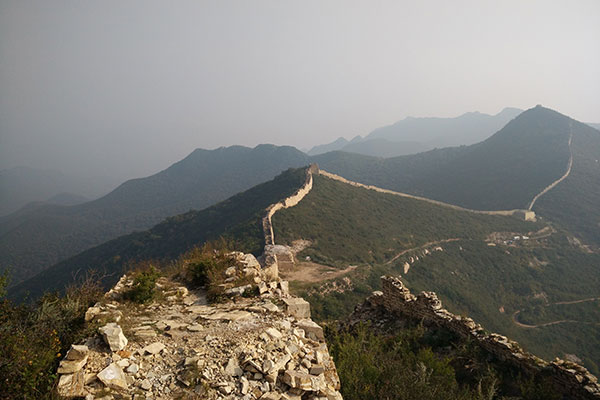
The Great Wall in Hebei province is facing challenges of time and neglect, but local authorities are trying to change the situation. [Wang Kaihao / China Daily]
Wang Gang leads local efforts to preserve the Great Wall in Zhangjiakou, which is a city in northern China’s Hebei province. He and a tiny team from the municipal administration patrol some 1,800 kilometers of the Wall that zigzags through mountains, in practices that have been going on since 2013, with four major patrols a year and each lasting a minimum of 45 days.
Wang expects data updating of the Wall in Zhangjiakou to be completed in the next three years. The expansion of construction activities in urban and rural areas of Zhangjiakou has made it necessary to have regular patrols of the Wall, he says.
Most Great Wall remains in Hebei are from the Ming Dynasty (1368-1644), when parts of the Wall were built to defend against the Mongol threat from the north. For example, the 3-km-long Yangbian Great Wall, a section in Huailai county, was built during the reign of Hongwu (1368-98) as a model for other locations in China to follow.
But a part of that section collapsed due to neglect. Broken rocks scattered in the wild grass below and no crenels survived, though they were said to have been 1.5 meters high. Years have passed without any restoration of the Yangbian section.
“The Wall is still collapsing,” says Li Dingyuan, director of Huailai County Museum. “Each year, there are several new collapsed sites.”
From the 1950s to 1980s, many people from the surrounding villages took bricks away from the Great Wall to build their own houses, Li recalls. And although the situation has been almost reversed today after sustained appeals to protect cultural heritage, time has been a greater challenge to overcome.
Wang’s team receives only 30,000 yuan ($4,700) a year to walk the Wall and gather data.
He wants to establish more county-level offices to supervise parts of the Wall and have institutions such as Li’s museum to assist them in taking care of remains of the Wall that fell to natural decay or human interference. But the limited grassroots expertise on cultural heritage protection isn’t giving Wang qualified field researchers.
“Yangbian is already much luckier than most other places on the Great Wall because some were lost before we knew of them,” Wang says. “The Wall is not always like Beijing’s Badaling. Many parts are hidden by farmlands or countryside roads.”
China promulgated a national rule to protect the Great Wall in 2006. It set a 500-meter protection zone on both sides, where construction activities are barred.
But Wang says it is impossible to isolate the Wall completely due to its close connection with Chinese people’s daily lives.
“Local villagers are sometimes probably even unaware that these stones or earthen fences are part of heritage,” he says.
Nevertheless, some places in Hebei now have come up with solutions. In Qinhuangdao, a seaside city about 500 km eastward of Zhangjiakou, a protection network has been set up.
“Some villagers grew grains using the Wall as a fence, and some fed sheep in the fortress,” Qiao Guohua, 59, says. “They don’t do that anymore.”
Qiao’s home village is at the base of a section of the Great Wall there. This man is among 22 rural people tasked with looking out for about 140 km of the Wall in Funing district.
They began as volunteers, but now they get paid 1,000 yuan a year for the part-time job.
In the past 11 years, Qiao and others have made people aware of the cultural significance of the Wall.
As a former police officer, he is also able to persuade tourists to leave the Wall without etching on it. Some visitors want to take home bricks as souvenirs for their “good luck” charm, he says.
But the young generations aren’t as “emotional about the Wall” as older Chinese are, Qiao adds.
The average age of the protection squad in Funing is 56.
According to Yang Dahai, director of Funing’s cultural heritage protection institution, a monthly salary of about 2,000 yuan might help get more young people into the fold.
“If we can have 850,000 yuan of financial support a year, we can maintain the Wall’s status quo in Funing,” Yang says. They only get 60,000 yuan annually.
Most famous sections of the Great Wall, which are popular tourist destinations, get more funds.
For example, ongoing restoration works covering 499 meters of the Wall in Qinhuangdao’s urban Shanhaiguan district is worth 50 million yuan. The restorers even have spare money to spend on designing a lawn there.
According to the State Administration of Cultural Heritage, the Great Wall today is nationally survived by a 21,196-km stretch, of which 6,259 km was built in the Ming Dynasty. But even among sections of the Wall that were built more recently, less than 10 percent are found to be “relatively well-preserved”, let alone those from the earlier times.
“The Great Wall represents the vicissitudes of Chinese history, which is reflected in the old look,” says Zhang Yimeng, a researcher at the Chinese Academy of Cultural Heritage.
Many past restorations had been done in ways to appeal to just short-term tourism resources.
“Should we keep creating new facades for those walls which already disappeared in the ancient times, or switch our attention to prolong the life of surviving parts?”
The answer needs a balance, he says.
